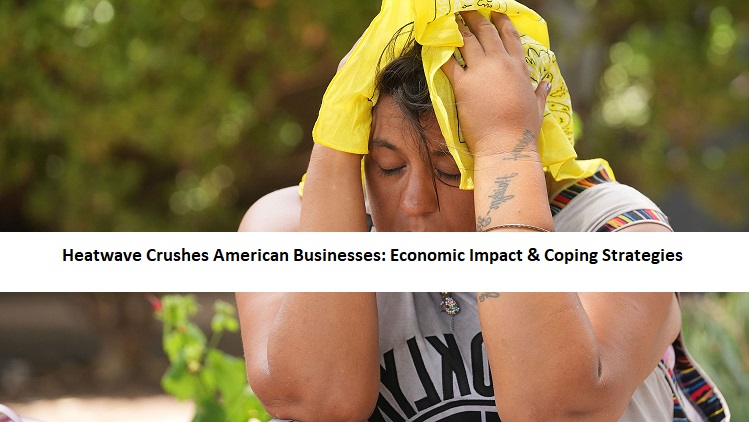Heatwave Crushes American Businesses: Economic Impact and Coping Strategies
A record-breaking heat wave is wrecking American businesses. The scorching heat is affecting Phoenix, Arizona, Holtville, California, and craft breweries across the country. Businesses face many challenges beyond weather adaptation as the summer desert heat arrives earlier, intensifies, and lasts longer. Entrepreneurs, workers, and industries are scrambling to deal with the heatwave’s economic impact.
Lyn Thomas, the determined owner of Zydeco’s Louisiana Kitchen Food Truck and 2 Geaux walk-up window, serves authentic Cajun and Creole dishes from generations-old recipes. The Phoenix heat has forced her to rethink her business strategy. Thomas cannot park her food truck and wait for customers due to 23 days of temperatures above 110 degrees Fahrenheit. She now caters to relieve the harsh weather.
The full economic impact of this heatwave is unknown. Extreme heat could cost the US $100 billion per year in productivity losses. If unchecked, this sweltering phenomenon could erode one-sixth of global economic activity by 2100.
Outdoor workers are suffering as temperatures rise. Heat can reduce productivity in industries like agriculture and construction, where workers toil in the sun. Heat stress-related illnesses and cognitive impairment increase. Employers must provide ice, water, shade, and flexible working hours during peak heat to protect workers.
Jack Vessey, a fourth-generation farmer in Imperial County’s Holtville, the “carrot capital of the world,” is used to extreme heat. Vessey & Company, his family’s produce grower and shipper, follows state heat illness prevention regulations for its nearly 100 employees. As they prepare the fields for planting, they monitor the labor force and provide ice, water, and shade.
Young workers may overlook the risks, but businesses must educate them. Heat stress is often overlooked by invincible people. The Adrienne Arsht-Rockefeller Foundation Resilience Center director Kathy Baughman McLeod stresses the importance of raising awareness of this “invisible, silent risk.” Heatwave naming and health-based warning systems help protect workers, but the lack of national heat-specific worker protection regulations is concerning.
Businesses that work with animals have taken steps to protect them from the heat. Harrold Granthan runs the Broken Saddle Riding Company in Los Cerrillos, New Mexico. Horseback riding is limited to mornings and evenings in summer due to extreme heat. Shade, water, and “bloodsicles” and “fishsicles”frozen ice pops made from blood and fish, respectivelyhelp horses cope with the high temperatures.
During extreme heat, major attractions like the Phoenix Zoo must care for animals. Bonnie Mendoza, the zoo’s COO and CFO, describes the extensive measures taken to protect animals, visitors, and staff. Animal habitats have pools, shade, and heat-fighting treats. To protect humans, free tram service, ample water, and cooling system maintenance are provided.


Craft breweriesthe heart of American cultureare affected by this heatwave. Arizona Wilderness Brewing’s patios generate 60% of revenue. Sales have dropped since the pandemic due to the heat. Since brewing requires the right temperature, cooling systems are essential for employees and beer. Extreme weather delays harvesting of the popular seasonal watermelon Gose beer.
Businesses and the economy will struggle as the heatwave continues and intensifies. Economist Joshua Graff Zivin of the University of California San Diego warns that declining working hours and output may cause small quarterly GDP dips, an unprecedented situation in modern US history. Industries, governments, and communities must collaborate to find long-term solutions, implement heat-resilient strategies, and protect businesses and their employees.
In conclusion, the heatwave is scarring American businesses, exposing vulnerabilities and forcing them to adapt. It’s not too late to act despite the economic damage. Industry and the economy must be prepared for extreme heat as temperatures rise. Businesses and communities need coping strategies, regulation, and awareness to survive this relentless heatwave.
Our Reader’s Queries
What was the biggest heatwave in USA?
In July 1936, during the “Dust Bowl” era, the country experienced one of the hottest summers ever recorded. The intense heat was especially felt across the Plains, Upper Midwest, and Great Lakes regions. This scorching summer led to the tragic deaths of approximately 5,000 people nationwide.
What is causing the heat wave 2023?
The heat waves are linked to human-caused climate change, say scientists. Another factor is the El Niño phenomenon, which started in 2023. However, new research suggests that climate change is making El Niño even more intense.
How long will the heat wave last in Texas 2023?
The Dallas-Fort Worth region sizzled through 47 scorching days of 100-degree-plus temperatures this summer. September didn’t offer much relief, bringing eight more days of triple-digit highs. Meanwhile, Brewster County in southwest Texas sweltered with an average September high of over 103 degrees.
What was the worst heatwave in human history?
In July 1743, China experienced a scorching heatwave. On July 25, Beijing sizzled at a blistering 44.4 °C (111.9 °F), surpassing all modern temperature records.

